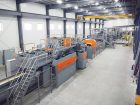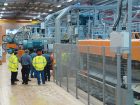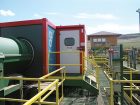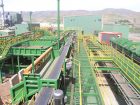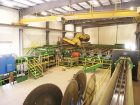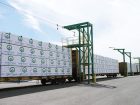
Features
Mills
Sawmilling
Eyes on the future
June 16, 2015 - To get a glimpse of the future of sawmilling you could do worse than cruise down US Highway 195 to Lewiston, Idaho. There, Idaho Forest Group (IFG) is in the midst of a US$60 million plus upgrade that includes the first HewSaw SL250 3.4 sawline in North America, among the finest operating stations this side of the Atlantic, and a Springer Microtec CT scanning system that may take some of the guess work out of log optimization. Mill manager Jesse Short says this reflects an innovation that starts right at the top.
June 16, 2015 By Scott Jamieson
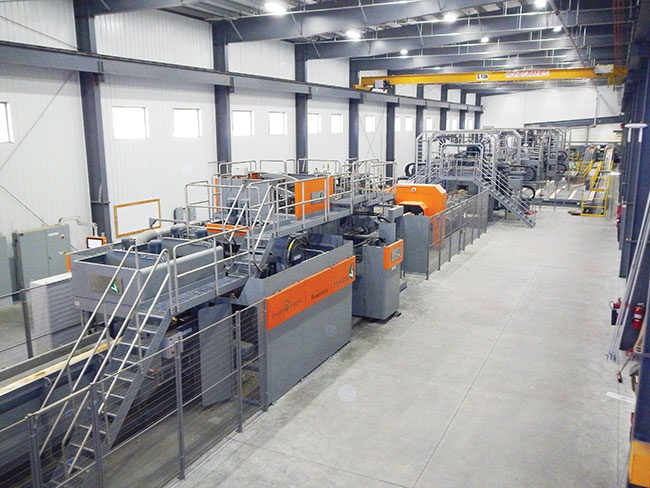 HewSaw SL250 3.4. To get a glimpse of the future of sawmilling you could do worse than cruise down US Highway 195 to Lewiston
HewSaw SL250 3.4. To get a glimpse of the future of sawmilling you could do worse than cruise down US Highway 195 to Lewiston“We’re really trying to promote a culture of innovation right through the company, and it starts with the enthusiasm of our owners,” Short says. “It’s contagious when you see the owners willing to invest in this level of technology.”
The principals at IFG are a pair of accountants with sawdust in their veins: chair Mark Brinkmeyer and president Scott Atkinson. The company operates five modern sawmills in Idaho with a combined capacity of over one billion bdft. Assembled through acquisitions and mergers dating back to the 1990s, IFG itself was formed through the merger of Bennett Forest Industries and Riley Creek Lumber in 2008. The move was designed to give the two companies the scale to survive a nasty recession, and that scale now allows IFG to invest in an array of new technology across all its mills.
The largest investment and most dramatic technological shift is the 2014-2015 upgrades to its Lewiston facility. The mill has added an efficient automated sawline next to its traditional bandsaw mill; built an impressive merchandiser deck, complete with CT scanning and 28 sort bins for the new HewSaw line; and is about to install a brand new high-speed planer line.
Much of the new gear reflects the mill’s future wood supply, with logs that are expected to get noticeably smaller over the next five years. IFG Lewiston gets over 60 per cent of its logs from private timberlands owned by Potlach Corp. (one of the mill’s former owners), and another 20 per cent from the State of Idaho’s Department of Land School Trust. That stable supply allowed IFG’s resource managers and owners to take a hard look at the future log supply.
“It’s not getting any bigger,” Short explains. “The new sawline was designed to handle that smaller wood more efficiently, and in many ways was built for our wood supply in a few years time. We’ll have a few challenges until then, dealing with the volume of larger timber that we’ll continue to get, but we’re now well set up for the future.”
From that forward look and a few trips to Europe, the owners and key managers came up with the new sawline concept. Detailed engineering was then done by Stolberg Engineering, although Short adds it was an aggressive timeline once the decision was made.
“We started building the sawline before the design on the merchandising system was finalized, but the two systems are distinct, so it worked out.”
Mill construction was started in the fall of 2013, and the first log went through the mill in April 2014. The merch system started up in the fall of 2014, with excavator-based delimbers filling the gap in between.
Doubling capacity
Short expects the mill to produce 240 to 270 million bdft this year and over 340 million bdft in 2016. The goal is to top 400 million bdft in the one mill, market willing, running two 8.5-hr shifts on the HewSaw and one shift on the big line. The mill currently runs 7.5-hour shifts.
That new production pace starts at the merch deck, which is a combination of Versatile Fabrication and Springer Microtec technology. Versatile handled the bulk of the log conveying and cutting technology, while IFG opted for a few Springer Microtec options to smooth the flow and enhance scanning.
Logs are loaded on the deck by crane, where operators have the option of removing defects with a Versatile cut-off saw. Following that, logs travel through the first Microtec CT scanner to work in a North American sawmill (see sidebar on page 42), and then through the first of a host of MPM Engineering scanning zones. MPM supplies all of the scanning throughout the mill, from merch deck and log sorting through the HewSaw line and at the trimmers.
“We thought long and hard about how we wanted to approach mill optimization with the new merch deck and sawline,” Short explains, “and in the end opted for a single optimization supplier and framework from front to back. The only exceptions are the CT scanner up front and our automated grader in the planer mill, which is Lucidyne. We feel that consistency and single technology pays off.”
Scanned logs go to a landing deck with a group of indexers that are there, in part, to buy time.
“Once the CT scanner is involved in driving decisions here, that’ll be a ton of data to crunch,” Short says. “These buy enough time to allow that decision to be made in real time.”
Logs are singulated for a Versatile three-saw merch-andizer, followed by MDI metal detection. Logs are put into one of four bins – one for a Springer dual-end flare reducer; one for the HewSaw logs up to 20-inches in diameter; one for the original larger log mill that is still operational, with an Optimil line for logs to 27 inches and a head rig run sporadically for over-sized; and a cull bin for remnant pieces or logs with metal.
The HewSaw logs get singulated again through a combination Linden Step Feeder and Springer Screw Feeder that Short says has really impressed. Logs are sent through an MPM scanner to re-establish sawing patterns, are oriented large end first on a Springer turntable, and then go to one of 28 external concrete sort bins (14 on each side of the sort chain).
“I was a bit skeptical about the turntable at first,” Short admits. “To me it seemed something that could become a problem area, but it works very well. They are ahead of the curve with a lot of their log handling equipment,” he adds of the Austrian supplier.”
Sorts are then collected in large quantities in the yard by two Volvo High-lift wheel loaders imported from Sweden. The mill had looked at domestic options, but the Volvos come from Sweden in the high-lift design and Short adds that the significant increase in fuel economy alone will pay for the machines in six years.
Logs are brought to the new sawline one sort at a time, where they are re-sorted into four bins, for a total sort capability of over 100 if the mill requires it. There are three ribbon-feed sorts by solution with the fourth bin used for scan-n-set logs.
“One of the things we are trying with the optimizer is to assign a penalty to those scan-n-set logs, as we have to lengthen the gap for those. We know the extra value we will get by scan and setting those logs – what we want to do is assign a cost as well. It may be at times that we are better to run these in one of the batch sorts.”
Logs are debarked on a new Nicholson 26-in A8 HYD debarker, then given a final scan for log rotation and positioning on the HewSaw dual-rotator (R2) positioner.
Efficient sawing
The objective behind the new sawline was to simplify the process as much as possible into a single, highly-automated line. The owners had seen similar set ups in Scandinavia and Scotland, and felt the approach would work for them.
The sawline is unlike the HewSaw lines most North American sawmillers are familiar with, starting with the extensive log sorting. This allows IFG to batch feed the overwhelming majority of its production. Scanning, optimization and controls on the new line were supplied by MPM while the hydraulics for the HewSaw were provided by Bosch Rexroth Canada.
The HewSaw SL250 3.4 is a four-phase breakdown line starting with true shape scanning, which orients the log for the positioner, followed by:
- A close-coupled four-sided curve chipping-canting process;
- A second scanner to optimize the solution for the Cant Saw, which then takes up to two fully-edged sideboards off the left and right sides of the cant;
- A Cant Turner, which turns the cant 90 degrees prior to the Ripsaw, which then curve saws the centre cant with vertically positioned saws followed by optimized sideboard processing that takes two more edged sideboards off of two sides;
- A final Cross Saw unit with horizontal saws that can optionally rip the larger centre stack into multiple smaller products or simply allow the boards to spill onto the landing table as is.
The line marries the simplicity of single-pass machines with the higher recovery of traditional multi-centre sawmilling for larger diameter logs. It’s also housed in an impressive sawing hall with natural lighting and a cavernous operating room with natural wood construction and video-game style operating station.
“The theory is if we provide a pleasant place for our operators to come to work everyday, they’ll stick around for a long time,” Short says in explaining the expansive stations.
The line started up in April 2014, and had its best shift to date on the Monday ahead of CFI’s April visit at 631,000 bdft in a 7.5-hour shift. Currently 75 per cent of production comes off the HewSaw line while 25 per cent comes from the big log mill – ironic given the much larger footprint and staffing needs of the big mill. Despite this, Short says they are still working with staff to get the true potential from the line on a consistent basis.
“One of the challenges we have is that this line can currently out-produce the market, so we’re trying to keep staff always motivated to improve. I know there is another gear for us on this line that we have not yet reached – we’ve seen them run elsewhere. We know that the market will improve – it always does – and we want to be in that top gear when it happens.”
Lumber runs through two trim lines, recently treated to an MPM Engineering optimization upgrade to replace a DOS-based system they inherited.
Drying is done in six Wellons kilns – four 100-ft double tracks that came with the mill and two 120-ft double tracks added in 2013.
“We have capacity for about 300 million bdft, and we intend to use it,” Short says with a smile.
Residuals are conveyed to the neighbouring pulp mill, which in turn, ports heat and steam back for the sawmill.
Future investment
With the sawmill and drying ready for future growth, IFG is in the midst of boosting productivity from the planer mill as well. As part of a $US8 million investment, the mill recently added Lucidyne automated grading technology, and has most of the steel on site for a brand new high-speed planer line from Quebec-based suppliers Carbotech and Gilbert.
The Lucidyne unit is the first of three currently running at IFG mills. “Once we got this one running and realized the accuracy and benefits, we bought two more for our other mills,” Short says.
Due to some downstream lumber handling options, IFG needs the system to be able to track graded boards through a number of hand-offs, where conventional systems would lose track. Lucidyne uses its True Queue camera system to take a two-foot “snap shot” of the board, giving it as fingerprint to ensure 100 per cent identification accuracy later on.
Lucidyne also manages the controls for the downstream gear, which includes a USNR fence and trimmer along with two sorters (tray and bin). A Samuel bar code labelling system completes the current set up.
The new planer line, which will be installed this summer, includes Carbotech lumber handling and infeed/outfeed systems, and a tilt hoist designed to pace the latest generation high speed Gilbert planer. The electric hoist will handle packages as high as 14 feet right from the kiln to reduce handling, and is entirely driven with servo-motors. To protect the appearance and edges of the lumber, the hoist includes a let-down chain to control the tier drops.
The planer, supplied in the west by Murray Latta, is Gilbert’s latest 10-head moulder/planer design, similar to another Gilbert unit going into IFG’s Laclede mill. IFG first put a Gilbert planer into its Chilco mill, so it is familiar with the technology.
“The Chilco planer works great, and this is the next version of their design,” Short says. “By the time we start ours up, the Laclede mill’s will be running for some time, so we’ll have the benefit of that experience to shorten the start-up curve.”
Once the new planer is humming along, there’s no doubt IFG will be looking at other opportunities to improve. Short says it’s one of the things that make good people stick around.
“From the owners right through, we really want to be the best, and that’s contagious. Whether it’s sports or a company, people want to be on the team that wants to be the best, and is committed to it. I think we provide that opportunity.”
Climate of innovation
Technology is fine, but mill manager Jesse Short explains that culture and attitude are the key drivers behind IFG’s growth, and are a big part of what keeps him excited to come to work each day. When asked what makes IFG different from most companies, Short keeps coming back to commitment.
“It’s the level of commitment to this industry by the owners that really sets the tone for the rest of us. They come to the mills, they’re very interested in the systems, how they work and opportunities to innovate. They’re not equity partners – they’re lumber people to the core.
Listing the attributes that make an ideal IFG team member, Short mentions commitment, entrepreneurial spirit and enthusiasm before stopping for a while on ownership. It seems IFG isn’t looking for too many passengers.
“We’re not necessarily looking for experience in most cases, and we tend to attract a bit of a blue collar crowd, people who are dedicated and want to get the job done. We’ve done well with farmers and loggers as a result. There’s a level of work ethic in our people that’s hard to create, and a sense of ownership and independence. That’s what we look for, and once people end up at IFG, they don’t tend to leave.”
IFG then works to marry those core values with a climate of innovation, a culture that again comes from the owners.
“A lot of the ideas we’re trying at our mills come from the owners. They are less involved in the day-to-day, more involved in industry issues and studying new and emerging technologies, different operating philosophies. They come up with these wild ideas, and then try to get one of us to bite. It’s an exciting environment.”
The next challenge at IFG, as at many innovation leaders, is to drive that love of innovation deeper into the company. The management team is working with its next layer of managers and supervisors to provide more opportunities to innovate.
“We’re looking at opportunities for them to build relationships with vendors and technology partners, go to technology events like Ligna or Portland, to get them the tools and resources to innovate.”
As one example of this, when they signed the PO on the HewSaw line, IFG sent 30 people to a similar line run by BSW in Scotland. The experience was irreplaceable, Short adds
Scanning the future
The first thing visitors notice on IFG’s new merch deck is the boxy Microtec CT scanner just ahead of the conventional MPM Systems scanner. While the CT scanner is currently collecting data to amass a library of scans on IFG’s log supply, mill manager Jesse Short says they have big hopes for the technology down the road.
“This is something of an R&D project for us,” he says. “We have a vision of using that CT scanner in a way that no one else is currently doing – we want to include the internal data points of a log before we choose a bucking and sawing solution.”
CT or computerized tomography is high-end X-ray technology that produces cross sections of the interior of objects, and is now a common tool in the medical field. Several lumber companies and Canadian researchers have used offline CT units to build data bases of “average” log profiles to help drive better decision-making. The unit at IFG Lewiston, however, is an online install designed to go beyond external geometric scanning as part of real-time optimization.
“We don’t want to guess anymore. If the log has number 3 grade knots in it we’ll put number 3 solutions into it.”
In fact, Short sees the day when they even pay suppliers by CT scan data computing true log value.
“It’s a long way from being more than an idea, but you have to start somewhere. We’re comfortable taking on that role at IFG.”
Print this page
